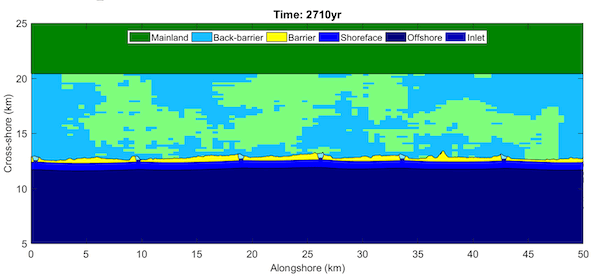J.H. Nienhuis1, M. Chen2
1 Utrecht University, This email address is being protected from spambots. You need JavaScript enabled to view it.
2 Florida State University, This email address is being protected from spambots. You need JavaScript enabled to view it.
Introduction
Barrier islands can migrate landward in response to sea level rise by transporting sediment to the back barrier, either through flood-tidal delta deposition, or via storm overwash. Our understanding of these processes over decadal to centennial time scales, however, is limited and poorly constrained.
Methods
Here we use a new barrier inlet environment (BRIE) model combined with remote sensing to quantify potential overwash and flood-tidal delta deposition rates. The BRIE model integrates existing overwash and shoreface formulations (Lorenzo-Trueba and Ashton, 2014) with alongshore sediment transport (Ashton and Murray, 2006), inlet stability (de Swart and Zimmerman, 2009), inlet migration, and flood-tidal delta deposition (Nienhuis and Ashton, 2016). Within BRIE, inlets can open, close, migrate, merge with other inlets, and build flood-tidal delta deposits. We use 34 years of remote sensing observations of barrier island change to parameterize overwash fluxes. The model accounts for feedbacks between overwash and inlets through their mutual dependence on barrier geometry.
Results
Model results suggest that when flood-tidal delta deposition is sufficiently large, barriers require less storm overwash to move landward and aggrade during sea level rise. In particular in micro-tidal environments with high alongshore sediment transport, tidal inlets are effective in depositing flood-tidal deltas and constitute the majority of the landward-driven sediment flux.

Figure 1: BRIE model showing inlets along a barrier island chain.
References
Ashton, A. D. and Murray, A. B.: High-angle wave instability and emergent shoreline shapes: 1. Modeling of sand waves, flying spits, and capes, J. Geophys. Res., 111(F4), F04011, doi:10.1029/2005JF000422, 2006.
Lorenzo-Trueba, J. and Ashton, A. D.: Rollover, drowning, and discontinuous retreat: Distinct modes of barrier response to sea-level rise arising from a simple morphodynamic model, J. Geophys. Res. Earth Surf., 119(4), 779–801, doi:10.1002/2013JF002941, 2014.
Nienhuis, J. H. and Ashton, A. D.: Mechanics and rates of tidal inlet migration: Modeling and application to natural examples, J. Geophys. Res. Earth Surf., 121(11), 2118–2139, doi:10.1002/2016JF004035, 2016.
de Swart, H. E. and Zimmerman, J. T. F.: Morphodynamics of Tidal Inlet Systems, Annu. Rev. Fluid Mech., 41, 203–229, doi:10.1146/annurev.fluid.010908.165159, 2009.










